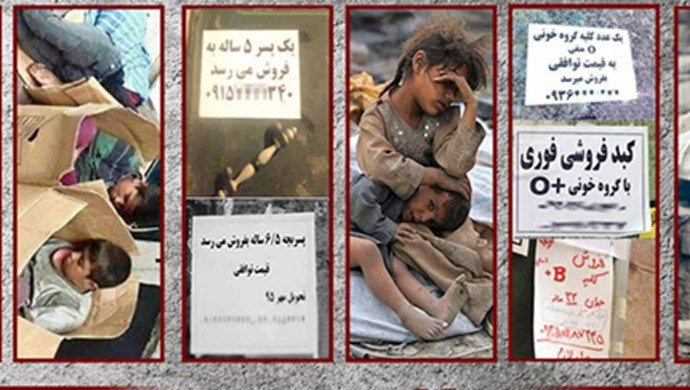Analysis by PMOI/MEK
Iran, May 18, 2021—A look at the assessments of Iranian government experts shows that the economy is in a dire situation. In May 2020, the Economic Affairs research Institute wrote: “A review of data and statistics from various institutions shows that Iran is not in a good position in terms of governance. This is evident in all the indicators that are built around the category of governance. Iran’s best ranking in 2018 is related to ‘government effectiveness,’ in which it is ranked 131st among 209 countries. But in other indicators, it is among the last 50 countries among more than 200 countries. The country’s position among the countries in the region (25 countries) is not very suitable, so that in all indicators except the government effectiveness index, it is one of the last 10 countries. In addition to the World Bank, other international institutions have confirmed that Iran is not in a good position in terms of good governance.”
Confirming the above observations, Information and Communications Technology Minister Mohammad-Javad Azari Jahromi admitted in the last days of his ministry. “Whether we like it or not, every day one of the thousands of faces of the pain of poverty and deprivation parades before our eyes. The pain of ‘survival’ that can neither be seen nor reacted to,” Azari Jahromi said, according to a May 11 report by Khabar Online news website.
“The government is deeply interfering in the market and thinks that the economy of a is a young child that will follow the government’s orders,” he added. With this statement, Azari Jahromi confirmed the government’s underperformance in “effective governance,” which was ironically the only item that the Economic Affairs Institute had evaluated Iran as being acceptable.
In the index of Government Effectiveness, the regime was ranked 131st and was considered good for the regime’s officials. But what about inflation?
On May 12, Tejarat daily wrote: “The most important challenge we have in the country’s economy is inflation. This chronic inflation, which we are facing more than four decades, reflects the inefficiencies and structural problems that exist in our economy.”
“The result of all these inefficiencies in the economy will be an increase in inflation, because eventually the government will have to solve these problems indirectly, without the people realizing it, by money printing,” Tejarat continued.
Iran’s economy suffers from mismanagement
In its report, Tejarat quoted Kourosh Sharafshahi, a member of Expediency Discernment Council, as saying, “There is no doubt that Iran’s economy is in turmoil. Mismanagement is the main challenge of the country’s economy, and we have been plagued by misgovernance in all the past years.”
Sharafshahi brought up several examples to back his claim, including massive tax evasion of high-income groups, boom in brokerage businesses and reduction of production, budget financing through oil sales and money printing, increasing the economic divide, a ballooning liquidity problem that grown sevenfold and exceeded 37,000 trillion rials, unsuccessful privatizations of companies, etc.
“The prices have become so high that minimum wage earners are fed up, and the increase in salaries and wages cannot meet these costs, which result in empty tables and breadwinners who are ashamed before their family,” he added.
“A fat and lazy government runs the country. About 3.5 million government employees shows how much we rely on government desks and chairs to create jobs. The same approach causes a lot of costs in the form of salaries and wages to be imposed on the country’s economy, in such a way that a large part of government revenue is spent on government salaries and benefits,” Sharafshahi said.
The regime’s official’s demagogy
Now let us look at another of the regime’s falsehoods.
In the last three weeks, Iranian regime officials have put a lot of pressure on the monetary and financial markets to reduce the exchange rate. Their goal is to say that the end of Hassan Rouhani‘s government, the dollar price fell below 200,000 rials. But by what mechanism?
They think that the nuclear deal negotiations will reach a relatively good result and the way to sell oil and foreign exchange resources will be opened, and so they are trying to sell the Central Bank’s cash reserves. By doing so, the price of goods will be reduced by a bit, and the plundered investors in stock market will be temporary relief so that everyone can see that Rouhani has been thinking about the people.
But the Daraian website warned on May 12, “Although the reduction of the exchange rate increases household welfare by lowering the price of imported goods, this welfare is not sustainable. Sustainable prosperity can only be achieved by increasing production. A lower exchange rate and higher imports will reduce domestic production, increase unemployment and reduce wages. If we keep the value of the rial higher than its real value through oil income, the advantage of the domestic producer will decrease. Reducing the domestic producer’s advantage means losses, unemployment, poverty, declining wages, and bankruptcy. Playing with the dollar rate for demagogic gestures has negative impact on the country, both in international negotiations and in domestic production and investment.”
From the misgovernment of yesterday to the scandalous demagoguery of today, we will reach the future of such a regime that has no future but destruction and annihilation.





